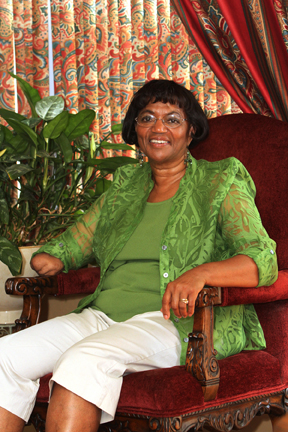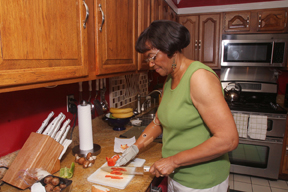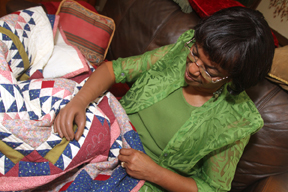Louise Hayes had a trailer full of assistants to help her dress as she transformed into a 1960s-era maid for her brief role in the new movie “The Help.”
All the attention was nice, but not necessary.
“I had to let them know I can do some things myself,” said Hayes, 72, who lost her right arm in a car accident four years ago and has since adapted well to the use of a prosthetic limb.
“I needed help with some of the buttons, but other than that, I could put everything on myself,” she said. “Still, it was really nice to have people there to cater to me.”
Hayes’ role involved wearing a gray pinstripe uniform and serving coffee to characters seated in a living room.
The movie, set to premiere July 30 in Madison, is based on the bestselling book by Jackson native Kathryn Stockett. It explores the relationships between African-American domestic workers and the white families who employed them during the segregation era in Mississippi.
Hayes’ role serves to illustrate the imperious attitude of the character Missus Walters — a woman so difficult to work for she “can’t keep a maid” and must settle for one who’s missing an arm.
Producers were able to find the right fit for the role by contacting Methodist Orthotics & Prosthetics in Flowood, a division of Methodist Rehabilitation Center in Jackson. It’s where Hayes was fitted for her first prosthesis after her accident.
“I got a call from Methodist Rehabilitation wanting to know if I was interested,” Hayes said. “When I told them I was, they put me in touch with the producer. He gave me a call, and I agreed to do it. It was just smooth sailing from there.”
Hayes provided photos of herself and details about her sizing so that her costume could be prepared. She arrived on location in Greenwood one day in August 2010, joined by her husband and sister. All of them were treated to the breakfast and lunch spreads served to the cast and crew.
“It was really nice, and the whole cast came out to eat while we were there eating,” Hayes said. “We got to see some of the stars of the show.”
After lunch, Hayes was taken to her trailer and began the process of transforming into her character. Hair, makeup and costume crews rolled her hair and dressed her simply in a uniform and loafers — all the details appropriate to the time and place, down to the undergarments.
“Maids weren’t supposed to look glamorous,” Hayes said.
The scene in which Hayes appears was filmed in the living room of a Greenwood home. The director and crew did several takes of the scene in which Hayes serves coffee to Hilly Holbrook, played by Bryce Dallas Howard.
In the scene, Hilly is on the phone to her mother, Missus Walters, played by Sissy Spacek.
“I was really taken aback to get the chance to talk to her,” Hayes said of Spacek. “She’s so down-to-earth, you really felt comfortable talking to her. My sister and I both got her autograph, and she wanted to know how I lost my arm.”
It was in January 2007 that Hayes and her husband, Luther, were riding down Highway 49 in Gulfport at night, when a truck towing an unlit flatbed trailer made a U-turn in front of them. They didn’t see the trailer until they hit it.
As their car turned in the impact, it flipped over into the road. Hayes’s husband was uninjured in the crash, but she sustained a bad cut across her forehead requiring a skin graft. Additionally, her right hand was crushed.
Doctors at the University of Alabama-Birmingham hospital had to remove her hand and lower arm, up to about three inches beneath her elbow. They referred her to Methodist Orthotics & Prosthetics to be fitted for a prosthetic limb, and soon Hayes was reclaiming her former life.
“It was a shock losing my arm, because I love to do things with my hands like cooking and sewing,” she said. “But I have taught myself to do a lot of things that some people are really surprised I can do.”
The prosthetic limb Hayes wears has two interchangeable hand attachments. Around the house, she uses a simple device that works like a clamp. When she goes out, she changes to a prosthesis that more closely resembles a natural hand, with fingers that move.
“It was awkward using it at first, but it only took me a week or two to catch on,” she said. “I realized all I had to do was flex my muscles, and after a while all I had to do was think about what I wanted to do and it just happened. I can open and close my prosthesis just like my real hand.”
The device is called a myoelectric prosthesis, said Larry Word, CPO, manager of the Methodist Orthotics & Prosthetics office in Hattiesburg. He fitted Hayes for a second prosthesis after her initial fitting at the Jackson office.
The prosthesis is powered by a battery pack and designed to register the movements made by the muscles in her remaining arm.
“We try to target the sites on the limb where you have active musculature,” Word said. “When the electric signal is generated by muscle contraction, the electrodes in the socket pick up on those impulses and will either open or close the hand based on which muscles contract.”
In Hayes case, Word was impressed with how well she adapted to wearing the prosthesis.
“Some people will get one and discover it’s a little heavy or tough to get on, so they may not wear it all the time,” he said. “But she never came in the office not wearing it. It did a lot to help her with her overall body image.”
It’s also become an essential part of Hayes lifestyle — not to mention a novelty for the children she teaches in Sunday School.
She has been able to add back virtually all the activities she enjoyed before the accident, including cooking, sewing quilts and making jewelry.
“The prosthesis enables me to do crafts, do things in the kitchen and just do whatever I need to do,” she said. “It’s almost like it’s my real hand.”
Hayes also spends time reading, and counts “The Help” among the books she enjoyed in the past year. She went out to get the book about a month before she was to report to the filming location, and soon noticed a lot of other people were reading it, too.
“Some of the story sounded familiar, and some of it didn’t,” said Hayes, who grew up in Hattiesburg. She lived abroad and traveled widely with her husband while he was in the military. They settled in Gulfport in 1969.
Hayes has since worked in accounting along with raising four daughters. While she never worked as a maid, she did work as a babysitter for a family when she was young and could relate to some of the characters’ experiences in “The Help.”
What she really connected with, though, was the experience of taking part in the making of a movie, as well as the anticipation of seeing whether her scene will make the final cut.
“It was a great experience,” she said. “It really made me want to do more.”



